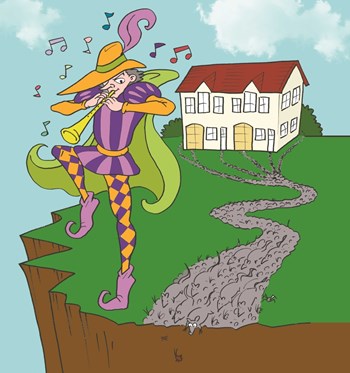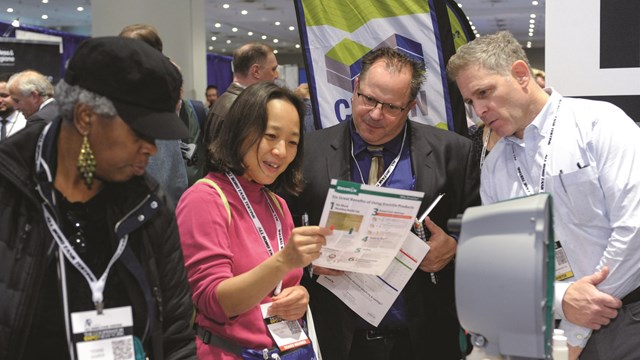
Jena Ball couldn't sleep—the noise was deafening and keeping her awake night after night. The racket wasn't coming from the next door neighbors, but instead was emanating from inside her condo wall. "It was bizarre," says Ball.
But even more bizarre was what was causing the sound. "Turns out, a hive of big black bees had bored into the outside walls of my unit," says Ball. "There were so many, the wall was actually warm to the touch. When the maintenance company found out, they sent in a special bee swat team. Apparently there are two varieties of these particular bees—one is noisy but harmless, but the other is very aggressive and their sting is toxic."
Ball was lucky—her bees were of the harmless variety, but the story is still frightening. Whether you are living in a condo in Japan or in the suburbs of Chicago, pests are an inevitable nuisance that can damage both landscapes and homes. Whether it's raccoons causing mayhem amongst your trash cans, termites lunching on your clubhouse, birds using your adjacent golf course as their own porta-potty, or deer grazing placidly on your meticulously-groomed grounds, it's a year-round task to keep pests away and property intact.
In this case, keeping pests away can sometimes be as dangerous as having them around. You and your family can become exposed to the pesticides just like the bugs you’re trying to kill. According to studies by the Environmental Protection Agency, various pesticides have been shown to cause eye, skin and respiratory problems, allergic reactions, headaches, vomiting, diarrhea, muscle weakness, and more, among humans.
“What wasn’t evaluated years ago was the exposure risk to pets and children and the persistence of chemicals in the environment,” says Steven Bessette, president and founder of EcoSMART Technologies in Atlanta.
Times have changed. Although battles continue with ever-present pests, the dawning of the Green Age has practically phased out toxic control methods in favor of more environmentally-friendly products and procedures.
What is That?!
But first, it’s best to understand what type of pests you’re trying to eliminate inside and outside and what kind of damage they are causing. Then you can create an effective treatment plan.
According to the University of Illinois Extension, based at the University of Illinois at Urbana-Champaign, and the experts interviewed for this article, ants, cockroaches, bedbugs and adult carpet beetles are just some of the most common or destructive pests inside Chicagoland buildings. Outside, the annual white grub is the most serious turfgrass pest in Illinois, along with Japanese beetles.
“Ants are the most common pests inside and outside,” says Vito Brancato, general manager of ABC Human Wildlife, Control & Prevention in Arlington Heights. “They can be a year-round problem and pick up in the summer time. Mostly they are just a nuisance, but carpenter ants can find areas of moisture and feed on wood that’s easy for them to consume.”
According to the U of I Extension, carpenter ants are drawn to indoor and outdoor areas with high moisture levels, such as bathrooms, basements, laundry areas, sweating or leaking pipes and crawl spaces. Outdoors, they can be found in the rotting wood of tree stumps and roots, and in moist areas under roof shingles, gutters, window sills, near chimneys, firewood, in untreated wood products or in the soil.
Grubs feed on turfgrass roots that will damage and kill grass. The damage appears as brown spots and when enough damage has occurred, the lawns looks like it’s rolled up carpeting. Japanese beetles destroy leaves, flowers and fruits and feed on grass roots in lawns, parks, golf courses, and cemeteries.
Bedbugs have been identified as the single most difficult pest to treat by members of the National Pest Management Association. “Bedbugs are a very serious public health problem,” says Rachel Lerner Rosenberg, executive director of Safer Pest Control Project. In 1994, a coalition of four environmental groups in Chicago—the Sierra Club, Illinois Environmental Council, Illinois Stewardship Alliance, and Business and Professional People for the Public Interest—partnered to address widespread concern over pesticide use, and founded the Safer Pest Control Project.
“We educate people on how to properly hire a pest control person who will do a first class job with the least impact,” says Rosenberg. “For example, ants can be eliminated very easily with a bottle of bleach and water or vinegar and water. Bug sprays don’t kill the nest or tell you why they are there. They're a waste of time, money and energy.”
She does say, however, that bedbugs are expensive to get rid of and are a burden on landlords and tenants alike. “In Chicago, it’s the landlord that bears legal responsibility for eradication,” she says.
Integrated Pest Management
Today, the eradication of any indoor and outdoor pests is called integrated pest management, or IPM. “IPM is where we don’t spray the heck out of everything,” says Bessette. “In the past, you would just go to the house, see where the pests were, and spray them. With IPM, you find where the pests are coming from, locate the cause of the problem and treat with the least toxic available tools. And that comes back to botanicals, which meets the government’s highest safety standards.”
For example, let’s say your building has a cockroach infestation. Instead of a general spray, an IPM program focuses on knowing how they are getting into the building. Is there food around? Are there holes in a wall? These are the conditions that need to be taken care of first. No access? No food? No bugs.
With bedbugs, to slow the spread in a building, management should remove clutter and dispose of any already-infested clutter, such as boxes, papers, toys and other objects in the common areas.
Orkin Technical Director and Entomologist Ron Harrison says that adult bedbugs can live for more than one year without feeding and sustain temperatures up to 113 degrees Fahrenheit as well as below freezing, which makes them difficult to control.
Extreme heat, in excess of 120 degrees and freezing can eliminate them. Harrison also explained that in multihousing buildings a wide enough net needs to be cast, otherwise other areas of the building may be infested. The freezing treatment is used with Cryonite, a directional wand and CO2. The technician treats the surface, cracks and crevices with a blast of cold to freeze the bedbugs.
Vern M. Kennedy, CEO of EcoSMART, says the trouble with bedbugs is they love teeny spaces, especially the bedroom. "The best way to get rid of bedbugs is not to get them in the first place," he says. "Since bedbugs are incredibly adept hitchhikers, the most reliable form of prevention is to find them when you travel and use a repellent to keep them out of your luggage in the first place."
And finally, to treat the already-existing pests, Bessette recommends botanical-based sprays. “If humans consume rosemary oil, it’s fine, but in an insect’s body, it binds to the receptors in the system and shuts it down,” says Bessette. “There’s no effect on people, pets or environment. That was the magic piece of the puzzle.”
For a non-chemical treatment of ants, Brancato suggests boric acid. According to the EPA, as an insecticide, some act as stomach poisons in ants, cockroaches, silverfish and termites, while others abrade the exoskeletons of insects. Boron occurs naturally in water, fruits, vegetables and forage crops, and is an essential nutrient for plants as well as an essential element for many organisms.
For a non-chemical treatment of annual white grubs, the U of I Extension recommends allowing the lawn to go dormant, which may help reduce egg-laying activity. For Japanese beetles, hand-picking can reduce population numbers. The use of traps may attract more beetles and therefore is not recommended. Selecting plants that are less preferred may be helpful.
“We want people to embrace really understanding the problem and figuring out why they have it,” say Rosenberg, who offers training to property managers and residents. “You can address the solution strategically. I’m excited about IPM. You’re using a step-by-step solution and the least toxic version available.”
Not everyone shares Rosenberg’s enthusiasm and convincing people that green is the way to go hasn’t been easy. “But there is more information available to the public now and it’s resulted in more patience and understanding about better solutions and better procedures that solve problems in a more complete way,” says Brancato.
He also says that inspection is the most important part of the problem. “Don’t make assumptions and just do a general application,” he says. “Instead, find the source of the problem.”
Not every company offers a completely non-toxic treatment for bedbugs or other pests, so discuss all of your options with the company you select.
Lisa Iannucci is a New York-based freelance writer and a frequent contributor to The Chicagoland Cooperator and other publications.






Leave a Comment